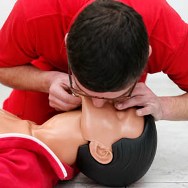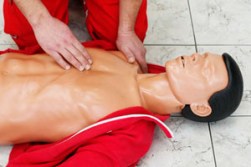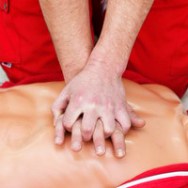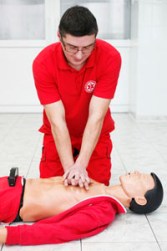How to do artificial respiration and external heart massage
The purpose of artificial respiration, like normal natural respiration, is to provide gas exchange in the body, i.e. saturating the victim's blood with oxygen and removing carbon dioxide from the blood. In addition, artificial respiration, acting reflexively on the respiratory center of the brain, thus contributes to the restoration of spontaneous breathing of the victim.
Gas exchange takes place in the lungs, the air entering them fills many lung bubbles, the so-called alveoli, to the walls of which blood, saturated with carbon dioxide, flows. The walls of the alveoli are very thin, and their total area in humans reaches an average of 90 m2. Gas exchange takes place through these walls, that is, oxygen passes from the air into the blood, and carbon dioxide passes from the blood to the air.
Oxygen-saturated blood is sent from the heart to all organs, tissues and cells, in which therefore normal oxidation processes continue, that is, normal life activity.
The effect on the respiratory center of the brain occurs as a result of mechanical irritation of the nerve endings in the lungs from the incoming air. The resulting nerve impulses enter the center of the brain, which is responsible for the respiratory movements of the lungs, stimulating its normal activity, that is, the ability to send impulses to the muscles of the lungs, as it is in a healthy body.
There are many different ways to perform artificial respiration. All of them are divided into two groups: hardware and manual. Manual methods are much less efficient and incomparably more labor-intensive than hardware ones. However, they have the important advantage that they can be performed without any adaptations and tools, that is, immediately after the appearance of respiratory disorders in the victim.
Among the large number of existing manual methods, the most effective is the mouth-to-mouth method of artificial respiration. It consists of the caregiver blowing air from his lungs into the victim's lungs through the mouth or nose.
The advantages of the "word of mouth" method are, as practice shows, it is more effective than other manual methods. The volume of air blown into the lungs of an adult reaches 1000 — 1500 ml, that is, several times more than with other manual methods, and is quite sufficient for artificial respiration. This method is very simple and can be mastered in a short time by everyone, including those without a medical education. With this method, the risk of damage to the victim's organs is excluded. This method of artificial respiration allows you to simply control the flow of air into the victim's lungs — by expanding the chest. It's much less tiring.
The disadvantage of the mouth-to-mouth method is that it can cause mutual infection (contamination) and a feeling of disgust in the caregiver. In this regard, air is blown through gauze, a handkerchief and other loose tissue, as well as through a special tube:
Preparation for artificial respiration
Before proceeding with artificial respiration, you must quickly perform the following operations:
a) free the victim from clothing that restricts breathing — unbutton the collar, untie the tie, unbutton the trouser belt, etc. NS,
b) place the victim on his back on a horizontal surface — a table or floor,
c) Move the victim's head back as far as possible, place the palm of one hand under the nape of the neck and the other press on the forehead until the victim's chin is in line with the neck. In this position of the head, the tongue moves away from the entrance to the larynx, thus ensuring free passage of air into the lungs, the mouth usually opens. To maintain the achieved position of the head under the shoulder blades, place a roll of rolled up clothes,
d) examine the oral cavity with fingers and if foreign contents (blood, mucus, etc.) are found in it, remove it, simultaneously removing the prostheses, if any. To remove mucus and blood, the victim's head and shoulders should be turned to the side (you can bring your knee under the victim's shoulders), and then, using a handkerchief or the edge of a shirt wrapped around the index finger, clean the mouth and pharynx . Then you need to return the head to its original position and throw it out as much as possible, as indicated above.
Performing artificial respiration
 At the end of the preparatory operations, the caregiver took a deep breath and then exhaled forcefully into the victim's mouth. At the same time, he should cover the victim's entire mouth with his mouth and pinch his nose with his cheek or fingers. The caregiver then leans back, freeing the victim's mouth and nose, and inhales again. During this period, the victim's chest is lowered and passive exhalation occurs.
At the end of the preparatory operations, the caregiver took a deep breath and then exhaled forcefully into the victim's mouth. At the same time, he should cover the victim's entire mouth with his mouth and pinch his nose with his cheek or fingers. The caregiver then leans back, freeing the victim's mouth and nose, and inhales again. During this period, the victim's chest is lowered and passive exhalation occurs.
For small children, air can be blown into the mouth and nose simultaneously, with the caregiver covering the victim's mouth and nose with their mouth.
Control over the flow of air into the victim's lungs is accomplished by expanding the chest with each breath. If after blowing out the air, the victim's chest does not expand, this indicates an obstruction of the airways. In this case, it is necessary to push the lower jaw of the victim forward, for which the caregiver should place four fingers of each hand behind the corners of the lower jaw and, resting his thumbs on its edge, push the lower jaw forward so that the lower teeth are before the above.
The best patency of the victim's airways is ensured under three conditions: maximum bending of the head back, opening of the mouth, pushing the lower jaw forward.
Sometimes it is impossible to open the victim's mouth due to convulsive squeezing of the jaws. In this case, artificial respiration should be done by the "mouth-to-nose" method, closing the victim's mouth while blowing air into the nose.
With artificial respiration, an adult should blow out sharply 10-12 times per minute (i.e. after 5-6 s), and for a child 15-18 times (i.e. after 3-4 s).Also, since the child has a smaller lung capacity, inflation must be incomplete and less abrupt.
When the first weak breaths appear in the victim, the artificial breath should be aimed at the beginning of the spontaneous breath. Artificial respiration should be carried out until deep rhythmic spontaneous breathing is restored.
Heart massage
When providing assistance to an injured person, the so-called indirect or external heart massage — rhythmic pressure on the chest, that is, on the front wall of the victim's chest. As a result, the heart contracts between the sternum and the spine and forces blood out of its cavities. When the pressure stops, the chest and heart straighten and the heart fills with blood from the veins. In a person who is in a state of clinical death, the chest, due to the loss of muscle tension, easily displaces (compresses) when pressed, providing the necessary compression of the heart.
The purpose of cardiac massage is to artificially maintain blood circulation in the victim's body and restore normal natural heart contractions.
Circulation, that is, the movement of blood through the system of blood vessels, is necessary for the blood to deliver oxygen to all the organs and tissues of the body. Therefore, the blood must be enriched with oxygen, which is achieved by artificial respiration. Therefore, artificial respiration should be performed simultaneously with cardiac massage.
The restoration of the normal natural contractions of the heart, i.e. its independent work during massage occurs as a result of mechanical stimulation of the heart muscle (myocardium).
Blood pressure in the arteries as a result of compression of the chest reaches a relatively high value - 10-13 kPa (80-100 mm Hg) and is sufficient for blood flow to all organs and tissues of the victim's body. This keeps the body alive while CPR (and CPR) is performed.
Preparation for heart massage is at the same time preparation for artificial respiration, since heart massage must be performed together with artificial respiration.
 To perform the massage, it is necessary to place the victim on his back on a hard surface (bench, floor or, as a last resort, place a board under his back). It is also necessary to expose his chest, unbutton clothes that restrict breathing.
To perform the massage, it is necessary to place the victim on his back on a hard surface (bench, floor or, as a last resort, place a board under his back). It is also necessary to expose his chest, unbutton clothes that restrict breathing.
When performing cardiac massage, the assistant stands on both sides of the victim and takes a position in which it is possible to lean more or less over him.
After probing the pressure point (it should be about two fingers above the soft end of the sternum), the caregiver should place the lower palm of one hand over it, then place the other hand over the upper hand at a right angle and press on the victim's chest, slightly assisting in this tilt of the whole body.
The caregiver's forearms and humerus should be fully extended. The fingers of both hands should be brought together and should not touch the victim's chest. Pressing should be done with quick pressure so that it displaces the lower part of the sternum down by 3 — 4, and in overweight people by 5 — 6 cm. The pressing force should be concentrated on the lower part of the sternum, which is more mobile.Pressure on the upper part of the sternum, as well as on the edges of the lower ribs, should be avoided, as this can lead to their breakage. You cannot press below the edge of the chest (on the soft tissues), as you can damage the organs located here, mainly the liver.
 Pressure (pressure) on the sternum should be repeated about 1 time per second or more frequently to create sufficient blood flow. After a quick push, the position of the hands should not change for about 0.5 s. After that, you need to stand up slightly and relax your hands without tearing them from the sternum.
Pressure (pressure) on the sternum should be repeated about 1 time per second or more frequently to create sufficient blood flow. After a quick push, the position of the hands should not change for about 0.5 s. After that, you need to stand up slightly and relax your hands without tearing them from the sternum.
For children, the massage is performed with only one hand, pressing 2 times per second.
To enrich the victim's blood with oxygen, it is necessary to carry out artificial respiration using the mouth-to-mouth (or mouth-to-nose) method at the same time as cardiac massage.
If there are two assisting persons, then one should perform artificial respiration, and the other should perform heart massage. It is recommended that each of them perform artificial respiration and heart massage in sequence, changing every 5 to 10 minutes. Motionless (and this may indicate an insufficient amount of blown air), it is necessary to provide help in a different order, after two deep blows, make 15 pressures. You must be careful not to press on the sternum during inhalation.
If the caregiver does not have an assistant and performs only artificial respiration and external heart massage, it is necessary to alternate the performance of these operations in the following order: after two deep blows to the victim's mouth or nose, the assistant presses 15 times on the chest, then again makes two deep strokes and repeats 15 pressures to massage the heart, etc.
 The effectiveness of external heart massage is mainly manifested in the fact that with each pressure on the sternum of the carotid artery, the pulse is clearly felt. fingers at the side, gently palpate the surface of the neck until the carotid artery is identified.
The effectiveness of external heart massage is mainly manifested in the fact that with each pressure on the sternum of the carotid artery, the pulse is clearly felt. fingers at the side, gently palpate the surface of the neck until the carotid artery is identified.
Other signs of the effectiveness of the massage are constriction of the pupils, appearance of spontaneous breathing in the victim, reduction of cyanosis of the skin and visible mucous membranes.
The control over the effectiveness of the massage is carried out by the person performing artificial respiration. To increase the effectiveness of the massage, it is recommended that the victim's legs be raised (by 0.5 m) during the external heart massage. This position of the legs promotes better blood flow to the heart from the veins of the lower body.
Artificial respiration and external cardiac massage should be performed until spontaneous breathing and cardiac activity are restored or before transferring the victim to medical personnel.
The recovery of the activity of the victim's heart is judged by the appearance of his own, not supported by massage, a regular pulse. To check the pulse, the massage is interrupted every 2 minutes for 2-3 seconds. The preservation of the pulse during rest indicates the recovery of the independent work of the heart.
If there is no pulse during the rest, the massage should be resumed immediately. The prolonged absence of a pulse with the appearance of other signs of revitalization of the body (spontaneous breathing, contraction of the pupils, attempts of the victim to move his arms and legs, etc.) is a sign of cardiac fibrillation.In this case, it is necessary to continue to provide assistance to the victim until the arrival of the doctor or until the victim is delivered to a hospital, where the heart will be defibrillated. On the way, artificial respiration and heart massage should be carried out continuously until the patient is handed over to medical personnel.
Materials from P. A. Dolin's book "Fundamentals of Electrical Safety in Electrical Installations" were used in the preparation of the article.
